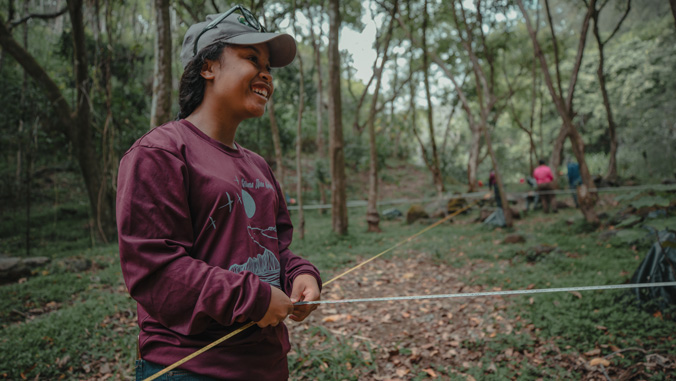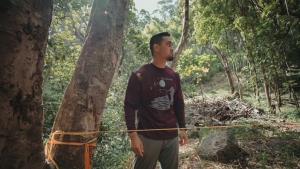
ʻĀina (land), culture and community generated an even deeper meaning for a group of students (haumāna) from the University of Hawaiʻi at Mānoa and UH Hilo this summer. After strictly attending classes during the pandemic from behind a computer screen, actually visiting wahi kūpuna or ancestral sites where Native Hawaiian royalty roamed centuries ago, sparked vivid emotions.
Haumāna participated in a Wahi Kūpuna internship, a four week long program where college credits are earned while working with historical and cultural experts in the archaeology field. This summer, students spent time conducting field work in Hāmākua on Hawaiʻi Island in a region where famous high chief ʻUmialīloa was born and raised. Haumāna focused on ethnography and ethnohistorical research and ʻāina-field techniques such as mapping and recording boundaries using GPS at various wahi kūpuna in the area that will be used for restoration work.
UH Hilo junior Lucon Route completed the program feeling refreshed and recharged in his pursuit of an agroforestry and Pacific Islander studies degree.

“This internship has far surpassed my expectations and provided me with fortunate experiences with knowledgeable mentors and skills that influenced my decision of interest within my academic studies under agriculture,” Route explained. “I highly recommend those who are interested within the line of preservation history to try and apply.”
The paid internship program is spearheaded by Huliauapaʻa, a non-profit organization overseen by Kelley Lehuakeaopuna Uyeoka, a UH Mānoa archaeology and UH Hilo anthropology alumna.
“The primary goals of this program are to develop leaders and advocates in Hawaiʻi’s Cultural Resource Management field by training more Native Hawaiians and kamaʻāina in both the cultural and technical sides of heritage stewardship, so they have a strong cultural foundation, elevate their kuleana to our places and communities, obtain higher education degrees, and gain professional skills to eventually secure jobs,” said Uyeoka.
Visionaries behind the organization’s steadfast mission also include Professor Kekuewa Kikiloi (Kamakakūokalani Center for Hawaiian Studies, UH Mānoa), Professor Kathy Kawelu (Anthropology, UH Hilo) and Tiffnie Kakalia (Native Hawaiian Health, John A. Burns School of Medicine) who are members of the board of directors at Huliauapaʻa.
The internship program launched in 2010 with support from Kamehameha Schools and has mentored more than 70 haumāna through conducting community based research and has transported participants to wahi kūpuna across ka Pae ʻĀina o Hawaiʻi Nei (Hawaiian archipelago), from Hawaiʻi Island to Kauaʻi.
Restoring pilina (connection)

Research is also safely conducted inside the classroom to prepare for fieldwork. Haumāna were led by instructor Kepoʻo Keliipaakaua, who is also a PhD student in the Department of Urban and Regional Planning at UH Mānoa. The face-to-face interaction was refreshing after an unparalleled year of social distancing.
“It made such a big difference to be able to physically be in the same room with these haumāna where I could pick up on little cues, like a haumana letting out an audible sigh, that tipped me off to the fact that there was maybe some sort of research roadblock that I could help them through,” Keliipaakaua said. “It’s one thing for haumāna to learn about the different winds, rains and moʻolelo (story) connected to an ʻāina through lectures or readings, it’s a completely different experience for haumāna to be able to set foot on ʻāina and feel these winds and rains themselves while feeling, and smelling the landscape around them as they connect their own personal experiences in these places with moʻolelo of ancestors and akua (deities) who interacted with these ʻāina in the past.”
This summer, Uyeoka’s organization partnered with community-based hui (organization) Hui Mālama i ke Ala ʻŪlili (huiMAU) which specializes in educating younger generations on wahi kūpuna restoration in Hāmākua.
“We understand that we may not see or taste the fruits of the seeds that we plant today in our lifetimes, but that is part of the exchange to restore balance,“ said Noʻeau Peralto, huiMAU executive director and a UH Mānoa political science and Hawaiian studies alumnus. “That is why it is so important that we invest our aloha, our time and our mana (power) in cultivating the future generations of aloha ʻāina in our place. Ultimately, the future generations will inherit the fruits of our action or inaction.”


